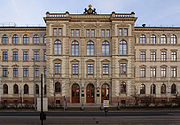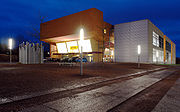
Chemnitz University of Technology
Encyclopedia


Chemnitz
Chemnitz is the third-largest city of the Free State of Saxony, Germany. Chemnitz is an independent city which is not part of any county and seat of the government region Direktionsbezirk Chemnitz. Located in the northern foothills of the Ore Mountains, it is a part of the Saxon triangle...
in Germany
Germany
Germany , officially the Federal Republic of Germany , is a federal parliamentary republic in Europe. The country consists of 16 states while the capital and largest city is Berlin. Germany covers an area of 357,021 km2 and has a largely temperate seasonal climate...
. With over 10000 students it is the third largest university in Saxony
Saxony
The Free State of Saxony is a landlocked state of Germany, contingent with Brandenburg, Saxony Anhalt, Thuringia, Bavaria, the Czech Republic and Poland. It is the tenth-largest German state in area, with of Germany's sixteen states....
and around 750 international students from 100 universities all over the world are enrolled each year. It was founded in 1836 as Royal Mercantile College ("Königliche Gewerbeschule") and became a technical university in 1986.
Foundation
The tradition of science in this region goes back to the 16th century with Georg AgricolaGeorg Agricola
Georgius Agricola was a German scholar and scientist. Known as "the father of mineralogy", he was born at Glauchau in Saxony. His real name was Georg Pawer; Agricola is the Latinised version of his name, Pawer meaning "farmer"...
, a famous German scholar of minerals, being the city's mayor. In 1836 the Royal Mercantile College was established as a scientific base to support the industrial revolution. In 1882 more than 1,000 students registered for this College. Modern scientific areas like electrical engineering were included in the studies. These developments made it possible that the institution became a Royal Technical Academy ("Königliche Gewerbeakademie"). Especially this academy helped Chemnitz to become one of the industrial centers in the beginning 20th century. At this time Chemnitz had the highest number of patent registrations in whole Germany and hence also in the whole world.
Inside the German Democratic RepublicGerman Democratic RepublicThe German Democratic Republic , informally called East Germany by West Germany and other countries, was a socialist state established in 1949 in the Soviet zone of occupied Germany, including East Berlin of the Allied-occupied capital city...
The city of Chemnitz was heavily damaged during the World War IIWorld War II
World War II, or the Second World War , was a global conflict lasting from 1939 to 1945, involving most of the world's nations—including all of the great powers—eventually forming two opposing military alliances: the Allies and the Axis...
with corresponding results for the Technical Academy. After some time of adaptation to the new conditions the status of a Technical College ("Technische Hochschule") was awarded in 1963. At the end of the 1960s the College was composed of faculties for Mathematics, Natural Sciences, Engineering and Humanities. With the rising number of students the institution became an official University of Technology in 1986.
After Germany's Reunification
At the end of the German Democratic Republic the academic system of Eastern Germany was absorbed by the West German system. Chemnitz was actively supported to remain as a third university besides Leipzig and Dresden within Saxony. Therefore, in 1992 and 1993 two new departments were established: The Department of Economics and Business Administration and the School of Humanities and Social Sciences expanded the university's broad field of studies towards a full university. Immediately these new schools started to work on interdisciplinary projects with the established science and engineering departments. The university introduced combined research projects and inter-facultary study courses. Within a few years the number of students doubled to the current level of around 10,000.Departments
The university is organised into the following 8 Departments:- Computer Science
- Economics and Business Administration
- Electrical Engineering and Information Technology
- Mathematics
- Mechanical Engineering
- Natural Sciences
- Humanities
- Behavioural and Social Sciences
Research
The university has concentrated its research to 6 main profiles:- New materials
- Production Life Cycle
- Microelectronics & Micro-electromechanical systems
- Applications & development of systems
- Communications, Media, Technology
- Modeling, Simulation, High Performance Computing

